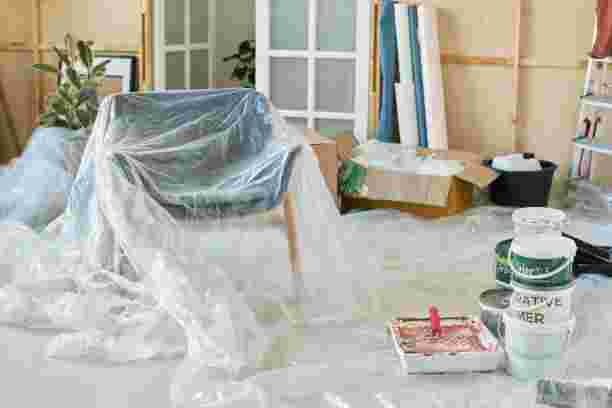Whether you're a weekend DIYer or a professional painter, maintaining a clean workspace is essential to achieving a polished, professional finish. One of the most critical tools in any painting kit is the paint drop cloths. Designed to catch spills, drips, and splatters, drop cloths prevent paint from damaging your floors, furniture, and other surfaces—making your painting experience efficient and stress-free.
What Are Paint Drop Cloths and Why Are They Important?
Paint drop cloths are protective fabric or plastic sheets used to cover areas not being painted. These cloths come in various materials, sizes, and thicknesses, offering versatility for both indoor and outdoor projects. Their primary role is to protect surfaces from paint drips, dust, debris, and even footprints.
They are essential for:
-
Maintaining a clean and safe workspace
-
Reducing cleanup time
-
Protecting floors, walls, and furniture from damage
-
Enhancing professional presentation for contractors
Without proper surface protection, even a small painting project can turn into a major cleanup job.
Different Types of Paint Drop Cloths and Their Uses
Choosing the right drop cloth depends on the type of job, work surface, and environment. Below are the most commonly used types:
1. Canvas Drop Cloths
-
Material: Made from woven cotton
-
Ideal for: Indoor use on hardwood, tile, or carpet
-
Benefits:
-
Reusable and durable
-
Absorbent and minimizes slipping
-
Lays flat without curling
-
-
Best for: Pros who work on frequent projects and want long-term value
2. Plastic Drop Cloths
-
Material: Polyethylene or vinyl
-
Ideal for: Outdoor or short-term indoor use
-
Benefits:
-
Waterproof and lightweight
-
Inexpensive
-
Disposable options available
-
-
Best for: Protecting surfaces from water-based paints and covering large areas quickly
3. Butyl Rubber-Coated Drop Cloths
-
Material: Rubberized backing with a canvas top
-
Ideal for: Heavy-duty protection in professional environments
-
Benefits:
-
Leak-proof
-
Anti-slip backing
-
Durable and reusable
-
-
Best for: High-traffic areas or vertical surfaces like stairs
4. Paper or Paper/Poly Drop Cloths
-
Material: Laminated layers of paper and plastic
-
Ideal for: Furniture or quick touch-ups
-
Benefits:
-
Lightweight
-
Disposable
-
Great for trimming and small projects
-
-
Best for: Quick jobs and interior furniture coverage
Choosing the Right Size for Your Project
Drop cloths come in many sizes, ranging from small 4’x5’ cloths for furniture to massive 20’x20’ tarps for whole-room coverage. To determine the right size:
-
Measure the total area to cover
-
Add extra footage for overhang or safety margins
-
Use multiple cloths if working in separate areas
-
Larger cloths are ideal for rolling and spraying walls or ceilings
Oversized cloths can be folded for flexibility, while undersized cloths may leave vulnerable gaps.
How to Use Drop Cloths Effectively for a Mess-Free Job
To maximize the effectiveness of your drop cloth:
-
Clean the surface first: Remove dust, dirt, and debris
-
Lay the cloth flat: Ensure it covers all corners and is wrinkle-free
-
Tape edges if needed: Especially when working with plastic or on stairs
-
Overlap cloths: For full coverage when using more than one
-
Move cloths as you work: Adjust as needed without dragging them
Using drop cloths correctly can prevent drips from seeping through or shifting during the project.
Benefits of Investing in Quality Drop Cloths
While budget drop cloths are tempting, investing in high-quality cloths pays off in the long run.
Key benefits:
-
Reusable: Washable canvas cloths can be used over and over
-
Durability: Higher resistance to tearing and abrasion
-
Stability: Heavy-weight cloths stay in place better
-
Absorbency: Canvas and butyl cloths absorb better than plastic
Frequent painters should look for products that are both absorbent and leak-proof.
Indoor vs. Outdoor Use – How Drop Cloths Perform Differently
Different environments demand different drop cloth materials:
Indoor Tips:
-
Choose non-slip canvas or rubber-backed drop cloths for hardwood floors
-
Avoid thin plastic on carpets—it may slide and cause accidents
-
Use painter’s tape to secure corners near baseboards or doors
Outdoor Tips:
-
Select waterproof tarps for moisture-prone areas
-
Secure with weights or clips to prevent wind lifting
-
Avoid using heavy canvas on wet grass or soil—use poly or vinyl instead
Adapt the material to suit temperature, moisture, and foot traffic conditions.
Eco-Friendly Options and Sustainability Considerations
If sustainability matters to your household or business, consider eco-conscious drop cloth options:
-
Canvas: Natural fiber, biodegradable, and long-lasting
-
Recycled plastic: Some plastic cloths are made from post-consumer material
-
Reusable: Investing in one quality cloth instead of many disposables saves waste
By choosing the right type and reusing when possible, you contribute to less construction and renovation waste.
Safety Considerations When Using Drop Cloths
A poorly placed drop cloth can be a safety hazard, particularly in busy environments.
Keep in mind:
-
Use non-slip materials for smooth floors
-
Avoid bunching or folding where people walk
-
Tape edges to avoid trips
-
Clean up spills immediately—don’t rely on the cloth alone
Your painting environment should be as safe as it is clean and organized.
Maintenance and Storage Tips for Long-Term Use
Caring for your drop cloths ensures they remain effective:
-
Canvas: Shake off debris and machine wash if paint is water-based
-
Plastic: Wipe down with a damp cloth and roll up to store
-
Store dry: Moisture can lead to mildew or warping
-
Label by use: Separate cloths used for interior vs. exterior or oil vs. latex paint
Proper care extends the lifespan of your investment and maintains professional standards.




